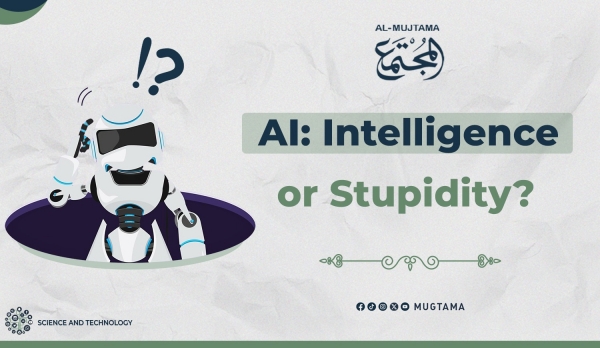Although the term "artificial intelligence" has become familiar to many people, and everyone is constantly repeating this term and promoting it as the technological revolution that will change the world, many studies have confirmed that these systems are not as intelligent as some believe. Instead, what has emerged is known as "artificial stupidity." Supporting these findings is a report from the Massachusetts Institute of Technology (MIT), which indicated that AI algorithms make errors ranging from 7% to 35% in image recognition when there are slight changes in colors or angles. In contrast, a five-year-old child can easily correct these mistakes.
Another study from Stanford University found that 40% of intelligent chatbots provide incorrect answers when dealing with unusual or unfamiliar questions. AI systems have also made grave errors in the world of self-driving cars. Data from the National Highway Traffic Safety Administration showed that cars equipped with AI tools were involved in more than 400 accidents in just one year due to incorrect decisions resulting from difficulties in recognizing pedestrians or failing to read traffic signals. This raises the question: If AI is truly superior to humans, as some claim, why does it make simple mistakes that an ordinary person would not? Is it really true intelligence, or are these systems simply mastering artificial stupidity in a new way?
Defining Artificial Stupidity:
Artificial stupidity is a term used to describe the unacceptable or erroneous behaviors exhibited by AI due to its limitations and its failure to reach the level of human intelligence. Despite the tremendous advancements in AI, it still lacks human consciousness and true understanding, making it prone to making unexpected decisions.
The term "artificial stupidity" does not necessarily mean that AI and its tools fail to perform their tasks, but rather that they cannot comprehend things in the same way humans do. One of the biggest challenges developers face in this field is training AI models to understand natural language effectively, which requires vast amounts of data and training. Additionally, the reasoning behind AI decisions often remains unclear—decisions are made without understanding their causes or motivations, as AI relies solely on the data it is fed.
Causes of Artificial Stupidity:
Although AI has simplified many tasks and reduced the time and effort required for traditionally performed work, there are numerous errors that have led to what is known as artificial stupidity. These causes include:
- Lack of Contextual Understanding: AI relies on data and patterns but cannot interpret information like humans. For example, machine translation programs may provide literal but incorrect meanings.
- Bias in Data: Since AI learns from the input data, if that data is biased, the results will be too. Examples include hiring systems that exclude certain groups due to unbalanced training data.
- Algorithmic and Programming Limitations: AI systems operate based on fixed rules, making them incapable of creative or critical thinking. This is evident in self-driving systems that have caused numerous accidents.
- Difficulty Handling Unfamiliar or Rare Cases: AI excels at handling repetitive patterns but fails when faced with uncommon situations. Fraud detection systems, for instance, may produce incorrect results when encountering new fraudulent methods.
Potential Risks of Artificial Stupidity:
Despite significant progress in AI, artificial stupidity can lead to numerous risks across various fields, including:
- Incorrect Decisions in Critical Fields: Such as medicine, where AI may provide inaccurate diagnoses, leading to inappropriate treatments, or exclude qualified candidates based on biased criteria.
- Spread of Misinformation and Fake News: AI can generate convincing fake images, potentially manipulating public opinion.
- Errors in Self-Driving Systems: Leading to increased accidents and casualties.
- Technological Unemployment and Job Losses: Due to the replacement of human workers with AI tools.
- Security Vulnerabilities and Cyber Risks: AI systems may contain exploitable flaws, enabling advanced cyberattacks and financial fraud.
- Negative Social Impacts: Such as privacy violations and reduced genuine human interaction, weakening social bonds.
- Loss of Control Over AI: Potentially leading to dangerous and unpredictable behaviors.
How to Mitigate Artificial Stupidity:
Despite the challenges related to errors, bias, and lack of deep understanding, artificial stupidity can be reduced through several measures, including:
- Improving Data Quality: Eliminating bias by diversifying sources and monitoring content for any skewed representations.
- Cleaning Data: Removing duplicates and errors that could lead to inaccurate conclusions.
- Developing More Flexible and Intelligent Algorithms: To enhance contextual understanding, deeper meanings, and critical thinking.
- Enhancing Human Oversight: Particularly in sensitive fields, through dedicated review teams.
- Increasing Transparency in AI Operations: Clarifying the reasoning behind decisions and providing the public with information on how AI tools function.
- Addressing Security Risks: Strengthening cybersecurity to protect systems from hacking and data manipulation.
- Establishing Regulations for AI Governance: Requiring companies to review their systems' impact and ensure safe AI usage.
- Promoting AI Research and Development: Collaborating with specialized companies, universities, and academic institutions to develop smarter and safer technologies.
Conclusion:
From the above, it is clear that artificial stupidity is not merely a technical issue but a serious challenge that could affect personal safety, the economy, and society at large. Therefore, it is essential to develop AI to be safer, enhance human oversight, and reduce blind reliance on these tools. A balance must be struck between innovation and responsibility to ensure the safe and beneficial use of AI. After all, these are machines that cannot reach the level of intelligence and understanding possessed by the human mind.
-------------------------------------------------------------


